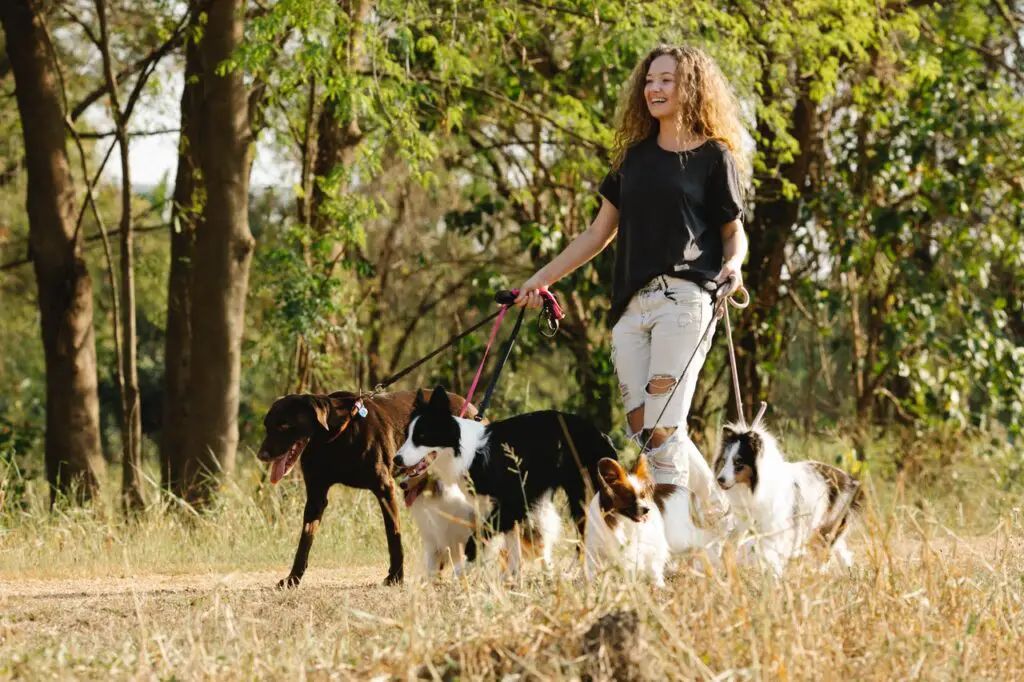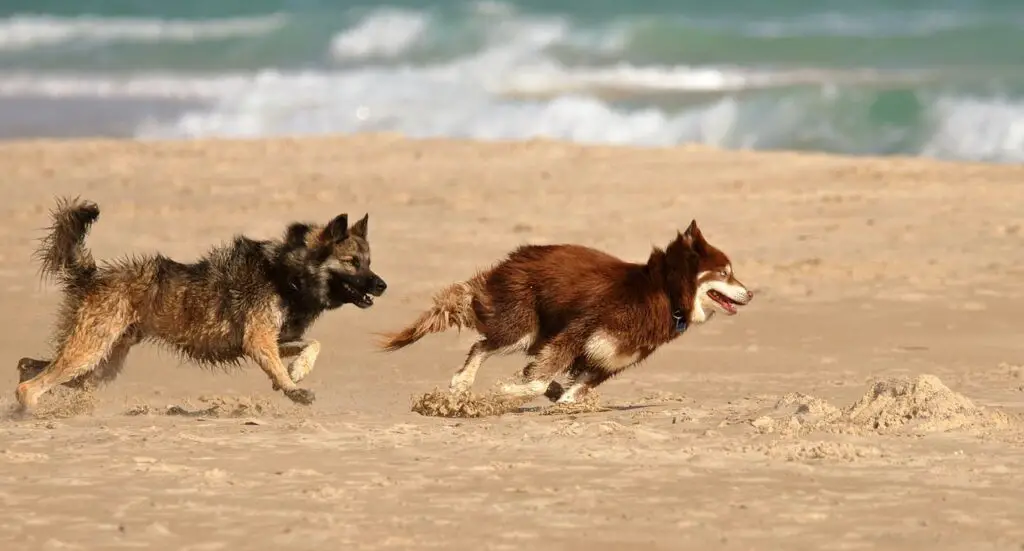In this article, we’ll explore the importance of taking your dog for a daily stroll — from physical health benefits to behavioral problems that may arise when dogs aren’t given enough stimulation. We’ll also discuss how proper training and socialization can help keep your pup happy and well-behaved. So why is it so important to walk your dog regularly?
If you do not walk your dog, the dog may become restless and start chewing on furniture or other objects in the house. If the dog is not walked, it may also relieve itself indoors. Dogs not exercising regularly are also more prone to developing behavioral problems.
The main reason why owners should take their furry friends outside regularly is that it provides an outlet for energy and mental stimulation. Not only will walking provide necessary exercise for keeping bones strong and muscles toned, but it’s also important for building trust between pets and their caregivers. It gives them time to bond with each other while exploring new sights and smells together in the great outdoors!
10 Reasons Why Walking A Dog Is Important
Walking a dog is like taking a child to the playground – an integral part of their development and growth. Dogs need exercise, playtime, and socialization to be healthy, happy members of our families. They can become destructive or sick without regular walks due to pent-up energy or anxiety.
- Provides exercise: Regular walking can help the dog and the owner stays physically active and healthy.
- Helps with weight management: Regularly walking dogs can help keep them healthy by burning calories and preventing obesity.
- Promotes mental health: Walking a dog can help reduce stress, anxiety, and depression in the dog and the owner.
- Builds a stronger bond: Walking a dog regularly can help strengthen the bond between the dog and the owner.
- Provides socialization: Walking a dog can help them interact with other dogs and people, which is important for their socialization and development.
- Encourages good behavior: Regular walking can help a dog develop good behavior and reduce destructive tendencies by providing an outlet for energy.
- Improves digestion: Walking after a meal can aid digestion for dogs and humans.
- Increases mental stimulation: Dogs need mental stimulation and physical exercise, and walking provides both.
- Helps with training: Walking can be an excellent opportunity to reinforce training commands and positive behaviors.
- Promotes a sense of purpose: Walking a dog can give the owner a sense of purpose and responsibility and make them feel needed and important.
We all know that physical activity is good for humans, but when we don’t provide our furry friends with daily walks, they miss out on this vital outlet. Walking keeps them physically fit and allows them to explore the world while strengthening the bond between pets and human parents.
Though these are just some reasons we should walk our dogs regularly, there are potential negative consequences if we forget or neglect this important task.

Potential Negative Consequences Of Not Walking A Dog
The importance of walking a dog is akin to the adage, “A tired dog is a happy one.” As much as we might like them, dogs require more than just love and affection—they need exercise too! Regularly scheduled walks are essential for their physical and mental well-being; however, not everyone follows through with this responsibility.
Neglecting to walk your pup can have some serious consequences. Dogs may become restless or destructive when confined indoors for long periods without regular outdoor activity. This could lead to behavioral issues such as excessive barking, chewing furniture, or digging holes. It could also lead to weight gain due to lack of exercise, which could cause health problems if left unchecked.
Furthermore, there’s an emotional aspect as well. Without ample socialization during regular outings, it can be difficult for our furry friends to learn how to interact properly with humans and other animals. With no chance to develop social skills, they’re likely to feel anxious and frustrated—which can manifest itself in negative behavior patterns inside the home.
TIP: Take advantage of technology by downloading a “dog-walking” app to remind you when to take Fido out! That way, you’ll never forget again while enjoying all the benefits of having a pet companion around the house.
Alternatives To Walking A Dog
If you don’t walk your dog, it’s like forgetting to put on your shoes for the day – a huge mistake! Not walking your four-legged friend can have serious consequences that should be avoided. Here are five alternative ways to meet your pup’s exercise needs:
- Taking them out in an enclosed yard or park
- Playing interactive games such as fetch and tug of war
- Going swimming with your pup
- Participating in agility classes together
- Hiring a professional pet sitter who specializes in outdoor activities
These alternatives will help keep your canine companion entertained while providing physical activity. However, nothing beats going outside and exploring nature together. Taking regular walks provides not only mental stimulation but also strengthens the bond between you and Fido. Introducing new sights and smells into their daily routine is essential for keeping their nose working and sharpening their senses.
By incorporating walks into your dog’s routine, you’re helping them stay physically and mentally healthy. Make sure to find a pace that works for both of you so everyone can enjoy the experience without feeling overwhelmed or underwhelmed; there’s no better way for dogs to get some much-needed fresh air than by taking regular strolls around the neighborhood!
Tips For Incorporating Walks Into Your Dog’s Routine
A leash is like a bridge connecting two worlds. On one side, the world of humans and their routines; on the other, the world of dogs and their instinctive needs. A walk allows us to understand each other better, create trust and build relationships – it’s a time for exploration, playfulness, and mental stimulation.
Consider many tips when adding walks into your pup’s routine. Firstly, remember that consistency is key: having regular times for walking helps your dog feel secure as they know what to expect every day. Secondly, vary up your routes so there’s always something new and interesting – this prevents boredom and provides mental stimulation. Finally, make sure that these walks aren’t just about exercise but also provide opportunities for socializing with people or other animals – plus, who knows where else your pup might lead you!
Taking all of this into account will help give you and your pet a more fulfilling experience together on those long-awaited walks. After all, why not turn them into wonderful adventures? So grab a leash (or even go without it) and explore everything that awaits outside!

How to Start Your Dog Walking Routine
Getting started walking your dog is an important part of ensuring their health and happiness. With just a few steps, you can establish a routine that will make going for walks more enjoyable for both you and your pup.
First, it’s essential to have the right gear. Invest in a comfortable collar or harness with enough room for growth. Ensure you also have plenty of poop bags – nothing ruins a walk like forgetting these!
Next, find the perfect route that fits both your lifestyle and schedule. This could be as simple as taking a daily stroll around the block or exploring nearby trails together. You may even try different routes occasionally to keep things interesting; variety is key!
Finally, consistency is key when starting any new activity with your pooch. Once you’ve established a plan, stick to it! This means setting aside dedicated times each day (or week) to go on walks together. Dogs thrive off routine, so they’ll soon come to expect their walks at certain points during the day – making them all the more excited about getting outside!
Frequently Asked Questions
What Type Of Exercise Is Best For My Dog?
When it comes to exercising our four-legged friends, there are many options. Walking is a great option, but it’s not the only way to keep your pup active. There are plenty of activities that both you and your furry companion can enjoy together!
Let’s talk about one of the most popular dog exercises: fetching. This game is perfect for those who don’t have a lot of time or space as it doesn’t require much equipment (just a ball!) and can be played in almost any environment — indoors or out. Fetch increases physical activity while also providing mental stimulation since dogs need to focus on finding and bringing back the object they’re chasing after.
Another fun exercise option is agility training, which uses obstacles like tunnels, jumps, and weaves poles. Agility helps build strength and endurance while allowing owners to bond with their canine pals through positive reinforcement techniques. It also encourages problem-solving skills, as dogs must figure out how to overcome each obstacle efficiently. Additionally, this exercise is beneficial because it allows participants to set goals and achieve success together—what could be better?
Exercising with your dog can provide countless health benefits for humans and animals alike, so why not take advantage of these opportunities? Not only will you strengthen your relationship with your pup, but you’ll also create memories that last forever!
How Many Times A Day Should I Walk My Dog?
If you’ve asked yourself how many times I should walk your dog a day, you have come to the right place! Walking your pup is essential for their well-being and can be an incredibly rewarding experience. As if that wasn’t enough, it’s almost like hitting two birds with one stone – because walking your pet will also help keep YOU fit and healthy!
The amount of daily walks required by each individual pup varies greatly depending on age, breed, size, and level of exercise they are used to. A general rule of thumb, though, is that most dogs need at least 30 minutes of physical activity every single day – meaning multiple shorter walks or one longer one is ideal. Moreover, taking them out in the morning and evening can create a much healthier routine for you AND your fur baby.
Walking may seem small, but trust us when we say its transformative powers are truly remarkable! It provides mental stimulation and builds the bond between you and your pooch while keeping them happy and healthy. So don’t wait another minute – grab those leashes and prepare to explore with Fido today!
What Should I Do If My Dog Doesn’t Like To Walk?
The golden light of the setting sun spills through the trees, casting long shadows across the park path. Taking a deep breath, you lead your pup to their favorite spot for a walk – only to be met with their uncharacteristic resistance. What should you do if your dog doesn’t like to walk?
It’s easy for humans to forget that our furry friends have individual needs and personalities just like we do! If they don’t enjoy walking, then it may be time to explore other options. Consider taking your pup on shorter walks more frequently throughout the day, switching up the environment, and trying somewhere different, like a beach or forest trail. You can also break up their exercise sessions into smaller chunks by playing fetch or tug-of-war instead.
Remember that some dogs will never love walking as much as others, no matter what solution you choose, but this shouldn’t stop you from spending quality time together outdoors. With enough patience, creativity, and understanding between you, chances are you’ll soon find something that works best for both of you!
What Are The Best Dog Walking Accessories To Buy?
We all know that walking your pup is an important part of their daily routine. But with the right gear, it can be fun and enjoyable for you and your furry friend! Explore some of the best dog-walking accessories to ensure every stroll succeeds.
First off, let’s start with something necessary: a leash. Whether you go for leather or nylon, choose one that suits your pup’s size and personality. For example, if you have an active pooch who loves to run around and get into mischief, look for a retractable option, so they still have freedom while staying safe.
Next on our list are harnesses – these provide better control than collars because they help distribute weight more evenly when pulling against them. They come in different sizes and styles depending on what kind of adventure you two will embark upon together. Plus, many models feature reflective strips that can keep your pet visible at night or during low light conditions – great for those late evening walks.
Treat bags are also handy items to bring along – this makes it easier to reward good behavior while out on the path and store any other essential items like poop bags or portable water bottles (which we recommend bringing just in case!). Not only do treat bags add convenience, but they can also act as a distraction from barking at nearby passersby.
So now that we’ve reviewed some critical pieces of equipment needed for successful walkies, grab yourself a leash, harness, treats bag, and anything else that might make your walks even more enjoyable…then take advantage of being outside in nature with your beloved companion!
What Is The Best Type Of Terrain For Walking My Dog?
Taking your dog for a stroll is like a trip to another world. It’s an opportunity to explore, discover and bond with your pet in ways that are otherwise not possible at home. But the type of terrain you choose is essential: it can make or break the whole experience.
A good starting point is knowing what kind of walk your dog likes best: flat ground or hills? If your pup loves running around, then open grassy fields may be ideal; if he or she prefers slow-paced walks, gravel roads could be perfect. The key here is finding something you and Fido will enjoy – so don’t hesitate to experiment!
Parks are also great spots for walking dogs because they usually have plenty of shade and trees for exploring (and maybe even some furry friends). Plus, many parks offer trails specifically designed for canine use, which makes them extra pawsome! Whatever option you choose, remember it should be comfortable enough for both you and your pooch – after all, those leisurely evening strolls shouldn’t feel like a marathon!

Conclusion
Concluding, finding ways to keep your dog active and healthy is essential. Walking is the best way to give them exercise, which can help prevent obesity and other health issues. According to recent studies, nearly 50% of all pet dogs in America are overweight or obese. As a responsible pet owner, it’s important to ensure your pup gets enough physical activity daily.
If you don’t have time for regular walks, there are still plenty of other activities your dog will love! From fetching balls at the park to playing tug-of-war indoors – there’s something for every breed and size of pooch. Investing in some good quality walking accessories like a leash, collar, and harness will also go a long way in helping keep both you and your pup safe during outdoor excursions.
Finally, remember that regular exercise isn’t just beneficial for your four-legged friend – I know from experience how enjoyable my daily walks with my doggo are! So get out there together and explore – happy trails!
